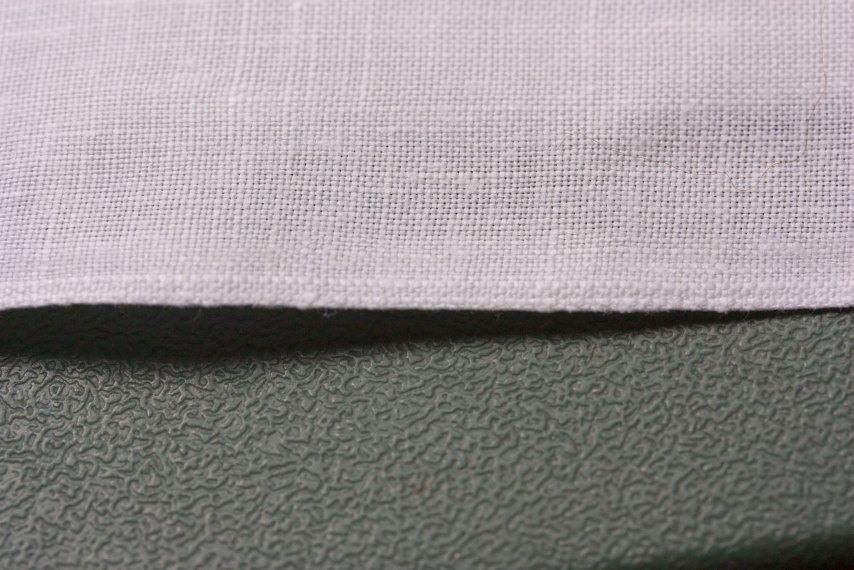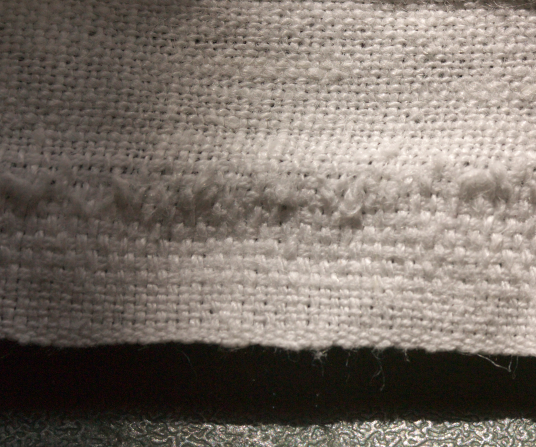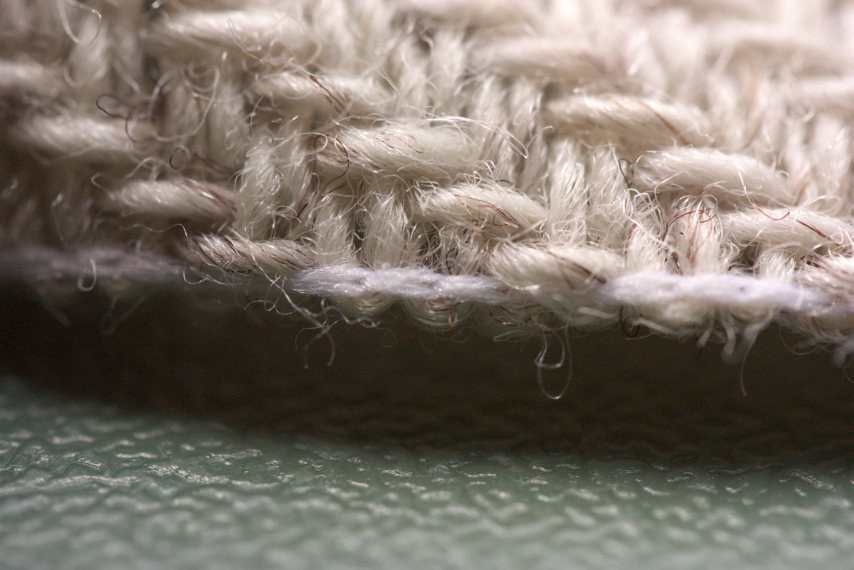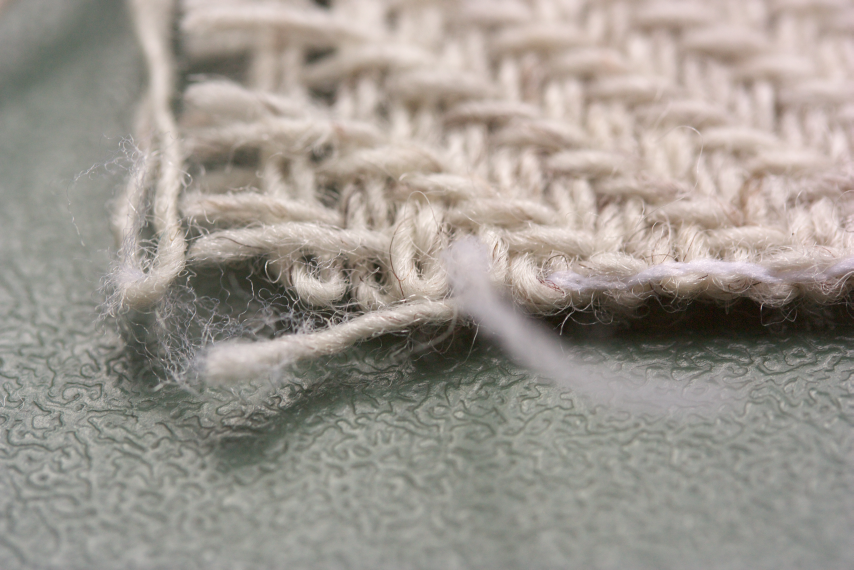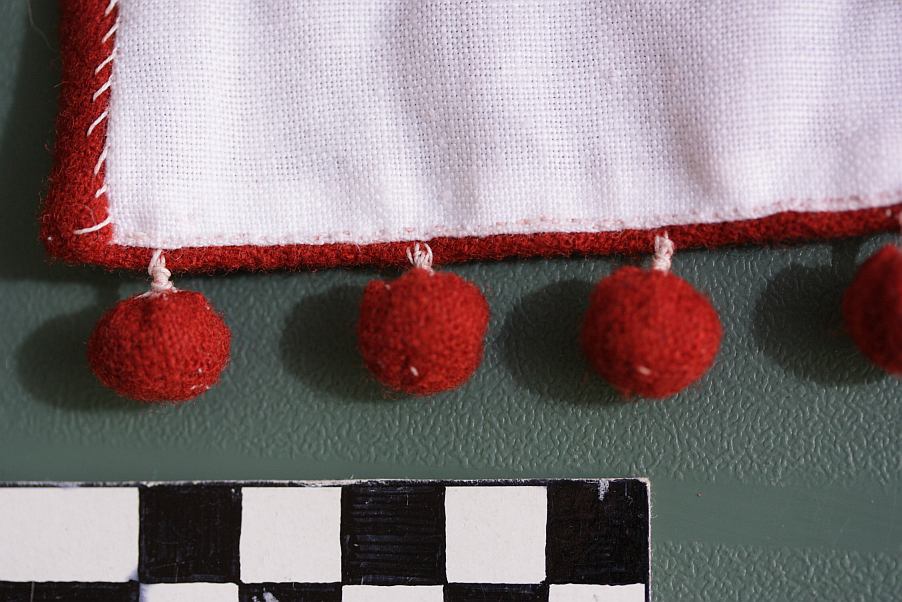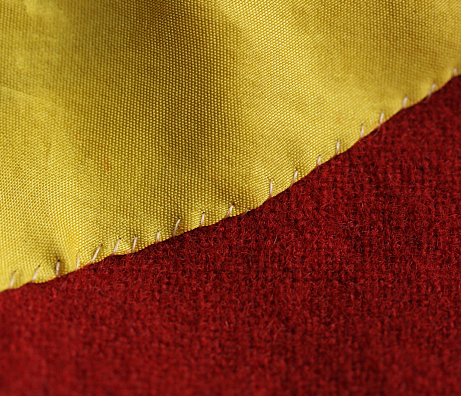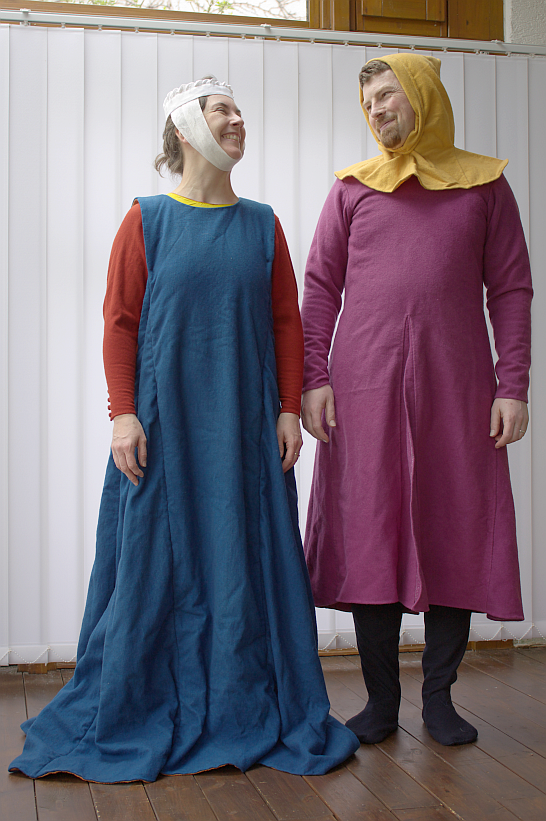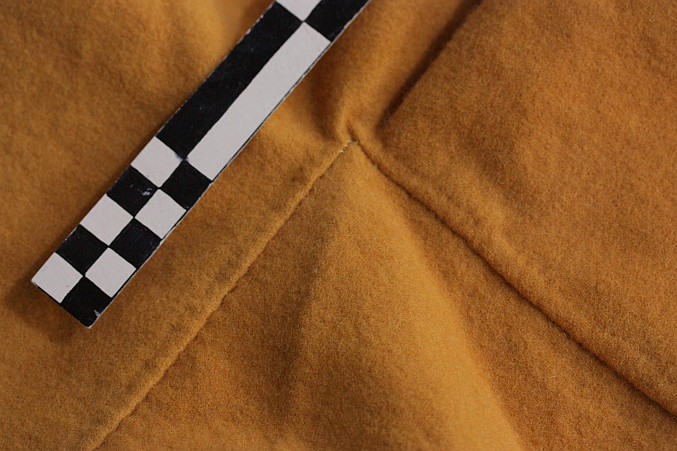There's this conference, started years ago by two textile archaeologists who felt it was a lonely occupation. It's taking place every three years, and it has grown a lot over time. Once upon a time, after it started, it was a smallish, private-ish conference where you needed to know someone to get in, and give a paper too. By now, it has become much more open (starting with the one in Copenhagen 2008, the first one that I attended), and you can just register and participate... provided you can stand the idea of having a large bunch of textile archaeologists talking textile, textile, textile, for several days in a row.
I'm talking about NESAT, of course. The wait is over, and after spending the weekend frantically getting everything that needed to be done before end of next week wrapped up, I am now on my way to Hallstatt. Where I will meet lots of lovely colleagues again, and finally get to see the glorious salt mines of Hallstatt. Where I will probably stay up way too late and chat way too much and have loads and loads of fun. Where I will have absolutely no time, and no inclination, to write a blog post for you (sorry, but that's the plain truth).
So I'm taking a blog break until June 2 (I'll be taking a few days off after the conference). Have a good time until then!
Monday 19 May 2014
Friday 16 May 2014
Friendly Friday List of Links
It's Friday, hooray! And since it's Friday, you are getting a list of links. Friendly links. That might or might not begin with an F, such as:
Fablab. I've posted about my visit to the FabLab Nuremberg, and just in case you are interested in learning more about these labs, here is the website of the international association of FabLabs, and here is a list with all of them, sorted by location. In case you are planning to make something on your first visit, I'd recommend checking out the website of your intended lab and preparing as much as possible - for instance, drawing the thing you're planning to lasercut or 3D print beforehand; these things eat more time than expected as a rule.
Finalist list for the Hugo Award, with links. I'll be going to LonCon this summer, together with Margit from Alte Künste, and that means I'll be a Hugo voter. I've linked to this list before, but in the meantime, I have actually managed to read some of the pieces, and they are delightful reading, so I link it again. Plus Finalist starts with an F.
Friends, as painted by Bob Ross. I've never watched more than a small snippet of his videos or shows, but this article about statistics in Bob Ross' work is delightfully geeky, and I enjoyed it a lot.
Fernsehen. That's German for Television, but if you need me to tell you, this link is not for you - it's a show of a series of educational television called "Experiment Mittelalter", with each episode about 15 min long. I've taken a glimpse into the first one and I'm not so sure about whether to link to this or not: It's a mix of commonplace knowledge without mentioning the many nuances, living history scenes that are not really bad but still cater to quite a few typical expectations and misconceptions (such as rough-hewn undecorated stone walls in the dining parlour and drab brown garments worn by almost everyones), but also nice glimpses at modern crafters working on replica pieces and with historical techniques. I'd recommend taking what is said with a grain of salt, maybe a bit more than a grain, and enjoy the pretty pictures - especially those of the crafters doing their thing. Having said this, go take a look and decide for yourself what you think of it, and I'd be happy to hear your opinion. It's here, and it's all German.
Fablab. I've posted about my visit to the FabLab Nuremberg, and just in case you are interested in learning more about these labs, here is the website of the international association of FabLabs, and here is a list with all of them, sorted by location. In case you are planning to make something on your first visit, I'd recommend checking out the website of your intended lab and preparing as much as possible - for instance, drawing the thing you're planning to lasercut or 3D print beforehand; these things eat more time than expected as a rule.
Finalist list for the Hugo Award, with links. I'll be going to LonCon this summer, together with Margit from Alte Künste, and that means I'll be a Hugo voter. I've linked to this list before, but in the meantime, I have actually managed to read some of the pieces, and they are delightful reading, so I link it again. Plus Finalist starts with an F.
Friends, as painted by Bob Ross. I've never watched more than a small snippet of his videos or shows, but this article about statistics in Bob Ross' work is delightfully geeky, and I enjoyed it a lot.
Fernsehen. That's German for Television, but if you need me to tell you, this link is not for you - it's a show of a series of educational television called "Experiment Mittelalter", with each episode about 15 min long. I've taken a glimpse into the first one and I'm not so sure about whether to link to this or not: It's a mix of commonplace knowledge without mentioning the many nuances, living history scenes that are not really bad but still cater to quite a few typical expectations and misconceptions (such as rough-hewn undecorated stone walls in the dining parlour and drab brown garments worn by almost everyones), but also nice glimpses at modern crafters working on replica pieces and with historical techniques. I'd recommend taking what is said with a grain of salt, maybe a bit more than a grain, and enjoy the pretty pictures - especially those of the crafters doing their thing. Having said this, go take a look and decide for yourself what you think of it, and I'd be happy to hear your opinion. It's here, and it's all German.
Thursday 15 May 2014
Registration for the Textile Forum is open!
The time has come - the Call for Papers and the registration form for our next Textile Forum are online. As usual, you can find them at www.textileforum.org.
This year, our conference will take place from 3-9 November, and our focus topic is "Plant Fibres: Materials, Techniques, Problems". We've touched on plant fibres now and then in the previous Forums, but there's usually much more been said and done on wool and silk, so we would like to have this as the focus topic for a change.
Just like we did last year, we're planning to make it a combination of papers and practical sessions, and we're looking forward to the suggestions and proposals coming in.
If you're interested in the Forum, or know someone who might be interested, please pass on the Call for Papers - we're happy to see it spread out!
This year, our conference will take place from 3-9 November, and our focus topic is "Plant Fibres: Materials, Techniques, Problems". We've touched on plant fibres now and then in the previous Forums, but there's usually much more been said and done on wool and silk, so we would like to have this as the focus topic for a change.
Just like we did last year, we're planning to make it a combination of papers and practical sessions, and we're looking forward to the suggestions and proposals coming in.
If you're interested in the Forum, or know someone who might be interested, please pass on the Call for Papers - we're happy to see it spread out!
Wednesday 14 May 2014
A textile mill, abandoned.
This has been going through facebook, where I stumbed across it - a textile mill that closed in 1980 was abandoned with all its machinery still standing, and has recently been photographed. Go see the pictures - it's stunningly beautiful and sad at the same time.
Also: How Football sounds to people who don't care about it. (Hint: The article replaces football with archaeology.)
And that's it for today, since I am taking a day off, in preparation of work this coming weekend (I will be in Bietigheim-Bissingen on Sunday, demonstrating spinning) and the NESAT conference soon after. I want my batteries full for that!
Also: How Football sounds to people who don't care about it. (Hint: The article replaces football with archaeology.)
And that's it for today, since I am taking a day off, in preparation of work this coming weekend (I will be in Bietigheim-Bissingen on Sunday, demonstrating spinning) and the NESAT conference soon after. I want my batteries full for that!
Tuesday 13 May 2014
Fabulous fabrication.
We have a regular (weekly, usually) session of "get excited and make things". It's a fixed day and time of the week, and most of the time, one or several friends drop by. They bring their projects and we all sit together and work on our things - knitting, sewing, woodworking, paper-related stuff. There's been miniature painting and programming done, too, as well as the very mundane task of mending socks and darning clothes.
Last week, our meeting went on an outing - into the FabLab in Nuremberg. Just in case you have never heard about a FabLab, it's short for "fabrication laboratory". Usually, a fablab is an open workshop where you can make things, for a very small fee.
Most fablabs have a set of tools for mechanical and electronic stuff, a laser cutter, and a 3D printer. You might also find a large drill, a CNC machine, a sewing and/or embroidering machine, a few computers, and some other stuff. Plus a stash of materials you can buy for your projects.
So, last week, I sat at the FabLab, designing new whorls and a new flyer and new bobbins for my little Finnish spinning wheel. I got that wheel back in 2012, and it's been running with the roughly tweaked flyer and bobbins since. They do work, but they are a waste of space in the spinning assembly, since the flyer is huge and the bobbin is tiny. (The wheel seems to be called the Varpapuu Toika, and someone else was so nice as to post a video of it.)
As you can see, the flyer is... less than elegant. A waste of space, and energy, and I am going to replace it with a lighter one, with longer wings to accommodate a bigger bobbin. I'll space the hooks closer to each other too, and fit it with smaller whorls. Someone at the FabLab has offered me help with the metal axle, and the rest... I'll laser cut wooden parts for the bobbin ends and the flyer, probably drill holes through some leftover dowels for the bobbin cores, and the whorl bits will be 3D-printed. (3D-printing takes ages, AGES, so as I'm an impatient person and want several bobbins, I will just print the whorl disks.)
If you have a FabLab in your region - go check it out. They are fabulous!
Last week, our meeting went on an outing - into the FabLab in Nuremberg. Just in case you have never heard about a FabLab, it's short for "fabrication laboratory". Usually, a fablab is an open workshop where you can make things, for a very small fee.
Most fablabs have a set of tools for mechanical and electronic stuff, a laser cutter, and a 3D printer. You might also find a large drill, a CNC machine, a sewing and/or embroidering machine, a few computers, and some other stuff. Plus a stash of materials you can buy for your projects.
So, last week, I sat at the FabLab, designing new whorls and a new flyer and new bobbins for my little Finnish spinning wheel. I got that wheel back in 2012, and it's been running with the roughly tweaked flyer and bobbins since. They do work, but they are a waste of space in the spinning assembly, since the flyer is huge and the bobbin is tiny. (The wheel seems to be called the Varpapuu Toika, and someone else was so nice as to post a video of it.)
As you can see, the flyer is... less than elegant. A waste of space, and energy, and I am going to replace it with a lighter one, with longer wings to accommodate a bigger bobbin. I'll space the hooks closer to each other too, and fit it with smaller whorls. Someone at the FabLab has offered me help with the metal axle, and the rest... I'll laser cut wooden parts for the bobbin ends and the flyer, probably drill holes through some leftover dowels for the bobbin cores, and the whorl bits will be 3D-printed. (3D-printing takes ages, AGES, so as I'm an impatient person and want several bobbins, I will just print the whorl disks.)
If you have a FabLab in your region - go check it out. They are fabulous!
Posted by
a stitch in time
at
08:01
0
comments

 Labels:
and now for something completely different,
spinning,
things that I don't want to be without
Labels:
and now for something completely different,
spinning,
things that I don't want to be without
Monday 12 May 2014
The thing with looms.
There's two things I like to moan and groan about when chatting fabrics - number one: you just can't get the yarns anymore (or the guys to weave these yarns), and number two: there's a lot of modern fabrics that have no proper selvedges anymore.
And that's to do with the looms. Thing is - if you want to sell cheap fabrics, you need to have a loom that is fast, and work with materials that don't have a life of their own. Which means limp yarns, not spun as tightly old-fashioned hand-spun ones, in
a loom that is really, really fast... and these things will not give you proper selvedges.
Back when weaving was done with a shuttle, and where it is still done in this manner, you pass the shuttle through the shed, change sheds and pass the shuttle back. The thread, thus, makes a U-turn around the outermost thread(s) of your fabric. Adding in an extra thread or two to strengthen the selvedge was a well-known and quite commonly used thing, and having good selvedges that run straight and are even are a sign of good quality weaving.
If you want a fabric that meets all the criteria of a historical fabric, you have to have a good old-fashioned selvedge like that. Which also explains why I'm always happy to get something like this:
That is a proper, nice selvedge; a little bit stronger than the rest of the fabric but not too different in weave or density, and there's no plastic strengthening thread added to it. You can join two of these selvedges with overcast stitch just like it was done back in the Middle Ages and be happy.
The next best thing, and a type of selvedge more commonly found in modern fabrics, is looking like this:
It's still a proper selvedge, though not as nice and sturdy, and quite wide if you don't want to have the change in weave type show on the surface. There's also often a messy-looking area between the weave proper and the selvedge, also nicely showing in this specimen here. I wouldn't join two of these with overcast stitch if the join will be visible later.
Now let's go a bit more modern, yes? Proper selvedges require shuttle looms. These old-fashioned shuttle looms are slow, and modern industry likes its stuff to be faster - time is money and so on. So there's another type of fabric edge which really can't be termed "selvedge" any more... this one.
These are done with help of jets or projectiles, requiring cut threads as the weft. These weft threads, if fine enough, can be even carried by an air jet or a water jet. The result? A very, very fast loom (these are the fastest type today) but no selvedge whatsoever. The edges are, basically, cut edges with a little fringe and maybe some stabiliser thread along the edge. If you wanted to use the selvedge for extra strength somewhere... you're out of luck with this fabric type. If you wanted it to show somewhere... same thing applies. If you were planning to cut down on your sewing and hemming time with use of the selvedge, you just got a nasty surprise. You will have to treat every edge of this fabric like a cut edge, because that is what it is.
And then there's another little nasty surprise if you are looking for pure wool fabric in narrow widths. One of the two edges is a perfectly fine, normal selvedge, usually not reinforced by a double thread or anything.
The other edge, however... is not a proper selvedge. In fact, it's more like one of the cut-thread edges, only with a fold in the thread instead of the cut. The edge is held together by a fine, tiny crochet chain, usually done with a very fine thread made from man-made fibre.
It's not very obvious, and won't be visible or noticeable to most people, but it's not acceptable in case you want to have an as-authentic-as-possible equipment. If you remove the chain, you also remove the structural integrity of that edge.
If you want to have a pure wool band without that chain, though, you can take a sufficient length of the weft thread, a needle with a blunt tip and a large enough eye, remove the crochet chain and thread the extra thread through each of the edge loops. It might be advisable to remove the outermost warp thread for that, and to stock up on enough chocolate and motivation-enhancing drinks before.
Fun. Right? Thank goodness there are still some old-fashioned shuttle looms running!
And that's to do with the looms. Thing is - if you want to sell cheap fabrics, you need to have a loom that is fast, and work with materials that don't have a life of their own. Which means limp yarns, not spun as tightly old-fashioned hand-spun ones, in
a loom that is really, really fast... and these things will not give you proper selvedges.
If you want a fabric that meets all the criteria of a historical fabric, you have to have a good old-fashioned selvedge like that. Which also explains why I'm always happy to get something like this:
That is a proper, nice selvedge; a little bit stronger than the rest of the fabric but not too different in weave or density, and there's no plastic strengthening thread added to it. You can join two of these selvedges with overcast stitch just like it was done back in the Middle Ages and be happy.
The next best thing, and a type of selvedge more commonly found in modern fabrics, is looking like this:
It's still a proper selvedge, though not as nice and sturdy, and quite wide if you don't want to have the change in weave type show on the surface. There's also often a messy-looking area between the weave proper and the selvedge, also nicely showing in this specimen here. I wouldn't join two of these with overcast stitch if the join will be visible later.
Now let's go a bit more modern, yes? Proper selvedges require shuttle looms. These old-fashioned shuttle looms are slow, and modern industry likes its stuff to be faster - time is money and so on. So there's another type of fabric edge which really can't be termed "selvedge" any more... this one.
These are done with help of jets or projectiles, requiring cut threads as the weft. These weft threads, if fine enough, can be even carried by an air jet or a water jet. The result? A very, very fast loom (these are the fastest type today) but no selvedge whatsoever. The edges are, basically, cut edges with a little fringe and maybe some stabiliser thread along the edge. If you wanted to use the selvedge for extra strength somewhere... you're out of luck with this fabric type. If you wanted it to show somewhere... same thing applies. If you were planning to cut down on your sewing and hemming time with use of the selvedge, you just got a nasty surprise. You will have to treat every edge of this fabric like a cut edge, because that is what it is.
And then there's another little nasty surprise if you are looking for pure wool fabric in narrow widths. One of the two edges is a perfectly fine, normal selvedge, usually not reinforced by a double thread or anything.
The other edge, however... is not a proper selvedge. In fact, it's more like one of the cut-thread edges, only with a fold in the thread instead of the cut. The edge is held together by a fine, tiny crochet chain, usually done with a very fine thread made from man-made fibre.
It's not very obvious, and won't be visible or noticeable to most people, but it's not acceptable in case you want to have an as-authentic-as-possible equipment. If you remove the chain, you also remove the structural integrity of that edge.
If you want to have a pure wool band without that chain, though, you can take a sufficient length of the weft thread, a needle with a blunt tip and a large enough eye, remove the crochet chain and thread the extra thread through each of the edge loops. It might be advisable to remove the outermost warp thread for that, and to stock up on enough chocolate and motivation-enhancing drinks before.
Fun. Right? Thank goodness there are still some old-fashioned shuttle looms running!
Posted by
a stitch in time
at
09:24
3
comments

 Labels:
reconstructions,
textile techniques and tools,
work-related
Labels:
reconstructions,
textile techniques and tools,
work-related
Friday 9 May 2014
Thank goodness it's Friday.
I think I'm in really dire need of a weekend. Probably partly due to not having a proper weekend (or a proper rest day) due to Freienfels - which is lovely, but after a while tends to catch up with one.
Still, there are a few things I have to take care of today before the weekend can come. The cat is already very occupied with her most important late morning task: napping. Myself, however, I'm just now getting around to blogging...
...and you won't even get a totally lovely and exciting blog post, because while I have the idea for one or two (or even some more) posts, I need a bit more time and leisure to put those together.
Instead, you get this incredible example for craft skills on the street.
Still, there are a few things I have to take care of today before the weekend can come. The cat is already very occupied with her most important late morning task: napping. Myself, however, I'm just now getting around to blogging...
...and you won't even get a totally lovely and exciting blog post, because while I have the idea for one or two (or even some more) posts, I need a bit more time and leisure to put those together.
Instead, you get this incredible example for craft skills on the street.
Thursday 8 May 2014
Piccies!
Here are, finally, the long-promised pictures from the last big project - clothing for the newly opened museum at Burg Grünwald, Munich area.
I have not been there yet and have not been able to find photos, but as the museum only re-opened at Easter after extensive work on the castle and a redesign of the exhibition, that is not quite unexpected.
So you are getting the piccies I took before sending off the garments... with kind permission of my (very patient, and very lovely) models.
Let's start close to earth...
Obviously a lady has to wear more than just stockings - here is the red dress with its yellow silk neckband, and the barbe-and-fillet in the Manesse style.
Another closeup of the buttons on the dress. I just like closeups of these guys.
And a closeup of the seam fixing the yellow silk of the neck opening decoration. This cost me a lot more nerves than I had anticipated - but it turned out nice in the end!
Here are both models, completely dressed with the exception of the man's overgarment, which was not finished at that time.
And finally, a few more closeups of the man's purple tunic:
... and one of his hood:
There. It did happen. Picture proven.
I have not been there yet and have not been able to find photos, but as the museum only re-opened at Easter after extensive work on the castle and a redesign of the exhibition, that is not quite unexpected.
So you are getting the piccies I took before sending off the garments... with kind permission of my (very patient, and very lovely) models.
Let's start close to earth...
... midnight blue stockings for the lady, held with silk garter bands (braided) that you can't see in the picture (but they are there). That was lovely cloth and a pure joy to work with.
Obviously a lady has to wear more than just stockings - here is the red dress with its yellow silk neckband, and the barbe-and-fillet in the Manesse style.
Another closeup of the buttons on the dress. I just like closeups of these guys.
And a closeup of the seam fixing the yellow silk of the neck opening decoration. This cost me a lot more nerves than I had anticipated - but it turned out nice in the end!
Here are both models, completely dressed with the exception of the man's overgarment, which was not finished at that time.
And finally, a few more closeups of the man's purple tunic:
... and one of his hood:
There. It did happen. Picture proven.
Posted by
a stitch in time
at
08:47
0
comments

 Labels:
museum projects,
reconstructions,
work-related
Labels:
museum projects,
reconstructions,
work-related
Wednesday 7 May 2014
Captain Obvious sends his regards.
Obviously, not having internet access is a very good way to keep oneself from blogging. On the other hand, sitting somewhere more or less stranded and without internet is amazing at keeping distractions down and helping one get things actually... done. In this case, a few hours' worth of sewing.
A friend of ours needed a hand or, rather, someone to let the plumbers in while he's at work, so I was sitting there, waiting for them to finish their work, with my sewing kit to keep me occupied. Progress has been made (in contrast to when I was in Freienfels, where I managed to sew for about 5 minutes before something came up to interrupt my work*).
So, sorry for the belated blog post - I blame my lack of planning (I could have pre-blogged yesterday, right?) and me not being used to getting up that early, and totally forgetting that I had not blogged yet this morning. (The plumbers were a bit late, by the way. I could have blogged before leaving if I had known how much later they would be.)
* Taking the sewing kit to Freienfels was more or less just to keep me from fretting that I could have worked on it, which I surely would have done if I had left it at home. It's a rare event, though, where you actually manage to get all that done which you thought you might work on, at least in my experience. There's always something coming up - friends, some shopping, an unexpected but welcome chat, sudden hunger pangs that need to be dealt with, inquisitive people wanting to know what you are doing, you name it.
A friend of ours needed a hand or, rather, someone to let the plumbers in while he's at work, so I was sitting there, waiting for them to finish their work, with my sewing kit to keep me occupied. Progress has been made (in contrast to when I was in Freienfels, where I managed to sew for about 5 minutes before something came up to interrupt my work*).
So, sorry for the belated blog post - I blame my lack of planning (I could have pre-blogged yesterday, right?) and me not being used to getting up that early, and totally forgetting that I had not blogged yet this morning. (The plumbers were a bit late, by the way. I could have blogged before leaving if I had known how much later they would be.)
* Taking the sewing kit to Freienfels was more or less just to keep me from fretting that I could have worked on it, which I surely would have done if I had left it at home. It's a rare event, though, where you actually manage to get all that done which you thought you might work on, at least in my experience. There's always something coming up - friends, some shopping, an unexpected but welcome chat, sudden hunger pangs that need to be dealt with, inquisitive people wanting to know what you are doing, you name it.
Tuesday 6 May 2014
Back home!
I am back home from a nice and both relaxing and exhausting time at Freienfels. It was, as always, so nice to see all the people again that I know from, oh, ages back; it was lovely to have a coffee and a chat with friends, and to sit and enjoy the fire in the evening.
We also managed to do some shopping (because your equipment is just never complete, right?) and to enjoy some music. I got a few deliveries and some more leads on where to get special fabric, so that was quite successful.
Weather-wise, we were quite lucky, with only one day of light drizzling rain and grey skies. The rest of the time, it was sunny (though with some icy cold wind sometimes), and only the nights were freezing. Now the washing-machine is running, the cat is happy that her humans are back and is sleeping in her bed in the study, most of our equipment is already clean, dry and stowed away again - and I am back to the 21st century with its to-do lists and computers and deadlines and things to do and find out and take care of. Which I shall do, presently.
We also managed to do some shopping (because your equipment is just never complete, right?) and to enjoy some music. I got a few deliveries and some more leads on where to get special fabric, so that was quite successful.
Weather-wise, we were quite lucky, with only one day of light drizzling rain and grey skies. The rest of the time, it was sunny (though with some icy cold wind sometimes), and only the nights were freezing. Now the washing-machine is running, the cat is happy that her humans are back and is sleeping in her bed in the study, most of our equipment is already clean, dry and stowed away again - and I am back to the 21st century with its to-do lists and computers and deadlines and things to do and find out and take care of. Which I shall do, presently.
Subscribe to:
Posts (Atom)





